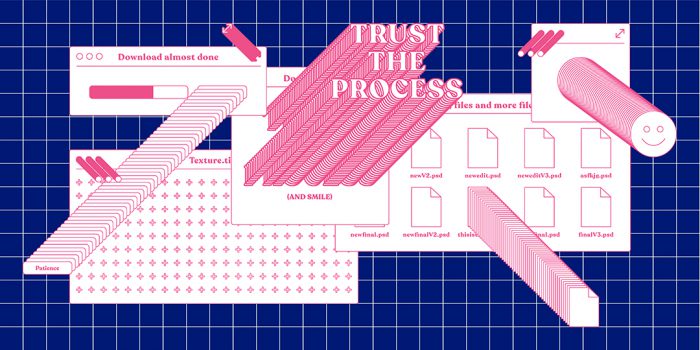Do You Need a Degree to be a Graphic Designer? Learn How to Become a Graphic Designer Without a Degree

At Shillington, we often get approached by prospective students who are eager to learn skills to start a graphic design career. Below we will demystify the pros and cons of getting a degree, share alternative learning resources and a variety of study options to learn design and how you can launch a career as a graphic designer.
Do You Need A Degree To Be A Graphic Designer?
A degree in graphic design isn’t essential to succeed in the industry and there are plenty of graphic designers from the past and present working in the profession who did not receive a design degree.
Although a design degree is not required, design education is important to gain fundamental knowledge and continue learning at every stage of your career. From bootcamp courses to online classes and books, there is a wealth of information to help with gaining the skills and knowledge that you need.
Attending university can help connect you with industry professionals, immersion in a creative community with classmates and teachers, and provide guided feedback on your work. But at its core, your success as a designer is determined by your portfolio, which is the most important part of finding a job and succeeding in the industry. The truth is, employers will not be looking at your degree in design to determine if you’re qualified for the job.
The industry thrives upon designers who can deliver a range of creative content in the arenas of advertising, book design, magazine design, information maps, typography and beyond. But how do you enter this vibrant profession? In short, credentials matter, but the options are more varied than you might think. We broke down a range of graphic design certificates in the United States, United Kingdom and Australia to give you an idea. However, most of them take much longer and cost much more than the Shillington 3 month full-time or 9 month part-time design courses courses.
Do Employers Value Or Require Them?
Employers want to hire people who are well-versed in the most up-to-date graphic design software programs, can complete projects from initial ideas to finished products and can thrive in a collaborative design team.
Sometimes being self-taught is simply not enough to survive in this kind of work environment, and may even be a recipe for getting underpaid. At Shillington, we teach all of these skills, but we also demystify the labor rights aspect of the industry that our students will enter. For example, we ensure that our students are familiar with typical graphic designer salaries and can identify their worth to employers and colleagues.
6 Successful Graphic Designers Who Never Got A Degree
- It’s no secret that the logo designers for AOL (Wally Olins), Barnes & Noble (Tibor Kalman), Coca-Cola (Raymond Loewy) and Volkswagen (William Bernbach) never received degrees in graphic design.
- Adrian Shaughnessy is a self-taught graphic designer who achieved great success in his career and known for his famous book, How to Be a Graphic Designer without Losing Your Soul.
- Another design superstar is Debbie Millman who launched the famous podcast, Design Matters. Although she also never had design training, she went on to work on redesign projects for over 200 brands and publish numerous books.
But the industry typically doesn’t award major advertising and creativity contracts on a lark! A degree can show hard-earned dedication to the craft and familiarity with the work field via formal accreditation. However, as these designers’ portfolios indicate, it ultimately takes a rare kind of flair to transform the design of everyday life. Shillington’s creative learning process guarantees that you will be inspired to reach these heights.
Advantages & Disadvantages Of Getting A Degree
In this current COVID-impacted moment, many people are forced to work from home, as companies discuss how to pare down their budgets. This year, affirming job security and a healthy work-life balance will benefit from having a certificate/degree in hand when you apply for graphic design positions. This challenging time has also compelled many people to re-evaluate their lives and to consider a career change into something more satisfying.
Receiving a graphic design degree can give you some competitive advantage and credentials to give your career a boost, especially as your career develops towards more managerial positions. Some companies may also award a higher salary to candidates who have higher education qualifications. Going to school also provides you with a well rounded background in design, working in teams and becoming experienced receiving critique on your work.
Studying within a structured program as opposed to independently gives you a more well rounded education, access to design professionals, networking and an opportunity to receive feedback on your design work from experienced designers, ensuring your work is polished and meeting industry standards. Being a part of a design community and receiving critique of your work is a big advantage to a design program. Apart from a well varied design training, a degree in design, especially from a prestigious school can be an emblem of achievement and look impressive on your CV.
The downside to getting a degree is the fact that it takes anywhere from 2 to 4 years and costs a wealth of money, along with possible long term debt.
A short term course can be the perfect option if you want to spend less time studying. Apart from the advantage of cost savings, you will also be able to develop a portfolio of work showcasing your technical skills and design thinking, which can all be achieved either through a shorter design course or self paced study. It will provide you with practical experience allowing you to gain skills to develop a portfolio and land a design job in a shorter amount of time compared to a degree at a university. As any designer knows, your portfolio is of utmost importance and the degree is secondary.
Free Online Courses
Of course, there are many ways to independently learn the arts and skills of graphic design. Below, we discuss some examples of non-accredited online platforms that offer free or low-cost classes. As you look into these resources, consider how entering the profession of graphic design requires a specific kind of training that these classes will not provide, but will help you excel with a short-term certificate course.
There are a many courses online taught by industry leaders to help you get a well rounded education in the essentials of graphic design such as design principles, color theory, typography, idea generation, mastering design programs (ie: Figma, Adobe Photoshop, InDesign and Illustrator), portfolio development and presentation.
If you want to start a new career by gaining new skills or to brush up on your design knowledge, then a short term course can be the ideal option for you. To help you out, we listed a couple of free courses you can start out with.
Coursera
Coursera offers design classes from universities and the majority are free. You can find topics on classes in UX, Innovation, Interaction Design and more. With each course, you complete a series of classes to master the skill, followed by a final project to earn your certificate.
CreativeLive
CreativeLive started off with the mission that each one of us has a creator within and that creativity gives us the fuel to create new things, make improvements and provide the spark to make change. There are classes which you can purchase for a fee or join in on their “On Air Today” featured classes for free which covers design classes on topics from freelancing to working with clients and design fundamentals.
Canva
For those with limited to no experience in design, the Canva Design School is a great way to learn the basics. You can find a few beginner resources to get you started to learn the basics of design which are broken down into bite sized chunks to simplify learning. Whether you want to get more skilled in Pinterest or learn how to create attention grabbing designs, there is a course for you here to get you started.
Courses & Bootcamps
Skillshare
With a paid subscription, you can take a variety of creative courses on the Skillshare online platform. Considered a “learning community for creators,” the classes are offered for all skill levels. Just sign up for a design class for this offering, watch the video lessons, create projects and participate in group discussions.
Udemy
Udemy is considered a “competitive classroom marketplace” and started as an online platform for students that want to learn and develop skills in a wide array of topics. Similar to other online courses, the topics on Udemy range from illustration to design essentials and UX.
Shaw Academy
The academy offers a 4 week trial to start and then turns into a paid subscription. In their design course, you will learn about design principles, design cycle, typography and the business of design.
Shillington
Apart from the free course options and the paid classes we just mentioned above, you can also consider Shillington’s graphic design course which offers the options of learning for 3 months full-time or for 9 months part-time. The course begins by exploring the foundational principles of graphic design (even if you’re a beginner), and students work on 30+ real-world projects ranging from print advertisements to thinking in 3D with packaging to designing a digital app.
Studying at a design intensive course not only provides you with access to the creative industry, but also a wonderful opportunity to gain real world experience by taking on design projects you will be working in-house at a company or design studio—which is essential combined with the design foundation you will learn.
If you do not want to spend the next two to four years studying design at a university, then Shillington’s hands-on course can be the perfect option for students wanting to study and graduate with design skills and portfolio in under one year. Although Shillington does not replace a university degree, it is a great alternative to gain practical skills and a portfolio of work so that you can launch a new career as a graphic designer. As a result of a shorter amount of time studying, Shillington graduates will graduate at least two years sooner than a university student and begin working in the industry.
When speaking to alumni after they graduated from Shillington, a huge motivating factor of studying in the course was the cost and the shorter duration of study since the majority of students did not want to pursue another degree which would take many years to complete. A degree in the UK, US or Australia can take anywhere from 36 to 48 months, which is 27 to 39 months longer than the 9 month part-time Shillington course. This is an important factor to consider since Shillington graduates will be working and earning a salary as a designer a lot sooner than their university counterparts.
Self-Taught
If you’re looking into becoming a designer, it’s important to learn the fundamentals of design, including a solid understanding of hierarchy, contrast, balance, typography and color theory. By spending some time learning about design history, you’ll become more familiar with the many possibilities of design and career trajectory. Plus, seeing the work of other creatives will train your eye and provide inspiration for future project ideas.
As part of your self-taught education, familiarize yourself with the design terms and see what is going on in the design world by following design blogs to discover other creatives and learn about the current trends. It’s important to know the rules of design in order to push your work further.
After you’ve developed a foundational understanding, the only way to get better at design is through practice and implementing what you’ve learned. You can push your skills further by participating in design challenges online or start your own design project. Working on self-initiated assignments can help you gain new skills by trying new things to get out of your comfort zone.
The wealth of classes available online, many of which are free or have a monthly fee can aid you in learning design at your own pace without a formal education. By studying on your own, you can take classes in subjects you’re interested in and discover areas you are passionate about such as website design, packaging or branding.
Conclusion
We hope this provides you with some useful resources on how you can learn design without the need for a degree. Consider it as the starting point to start exploring alternative ways of learning. The wide array of online courses and bootcamps will arm you with the foundation and technical skills needed to kickstart your creative career.
Feeling inspired and ready to take charge of your creative career? For some inspiration, here’s a round-up of 20 people who shifted careers by studying at Shillington.
Study graphic design with Shillington’s innovative course and become a designer in just three months full-time or nine months part-time. Shillington is the best way to learn graphic design no matter where you are in the world. Study online or at one of our six campuses in London, New York, Manchester, Sydney, Melbourne and Brisbane.
Artwork by #ShilloNYC Teacher Jimmy Muldoon
Want to win some amazing prizes and stay in the loop with all things Shillington? Sign up to our newsletter to automatically go in the draw.







